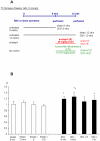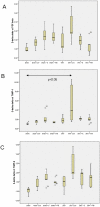High-dose enalapril treatment reverses myocardial fibrosis in experimental uremic cardiomyopathy
- PMID: 21298056
- PMCID: PMC3029304
- DOI: 10.1371/journal.pone.0015287
High-dose enalapril treatment reverses myocardial fibrosis in experimental uremic cardiomyopathy
Abstract
Aims: Patients with renal failure develop cardiovascular alterations which contribute to the higher rate of cardiac death. Blockade of the renin angiotensin system ameliorates the development of such changes. It is unclear, however, to what extent ACE-inhibitors can also reverse existing cardiovascular alterations. Therefore, we investigated the effect of high dose enalapril treatment on these alterations.
Methods: Male Sprague Dawley rats underwent subtotal nephrectomy (SNX, n = 34) or sham operation (sham, n = 39). Eight weeks after surgery, rats were sacrificed or allocated to treatment with either high-dose enalapril, combination of furosemide/dihydralazine or solvent for 4 weeks. Heart and aorta were evaluated using morphometry, stereological techniques and TaqMan PCR.
Results: After 8 and 12 weeks systolic blood pressure, albumin excretion, and left ventricular weight were significantly higher in untreated SNX compared to sham. Twelve weeks after SNX a significantly higher volume density of cardiac interstitial tissue (2.57±0.43% in SNX vs 1.50±0.43% in sham, p<0.05) and a significantly lower capillary length density (4532±355 mm/mm(3) in SNX vs 5023±624 mm/mm(3) in sham, p<0.05) were found. Treatment of SNX with enalapril from week 8-12 significantly improved myocardial fibrosis (1.63±0.25%, p<0.05), but not capillary reduction (3908±486 mm/mm(3)) or increased intercapillary distance. In contrast, alternative antihypertensive treatment showed no such effect. Significantly increased media thickness together with decreased vascular smooth muscles cell number and a disarray of elastic fibres were found in the aorta of SNX animals compared to sham. Both antihypertensive treatments failed to cause complete regression of these alterations.
Conclusions: The study indicates that high dose ACE-I treatment causes partial, but not complete, reversal of cardiovascular changes in SNX.
Conflict of interest statement
Figures





Similar articles
-
Reversal of glomerulosclerosis after high-dose enalapril treatment in subtotally nephrectomized rats.J Am Soc Nephrol. 2003 Nov;14(11):2833-42. doi: 10.1097/01.asn.0000095248.91994.d3. J Am Soc Nephrol. 2003. PMID: 14569093
-
Arteriolar wall thickening, capillary rarefaction and interstitial fibrosis in the heart of rats with renal failure:the effects of ramipril, nifedipine and moxonidine.J Am Soc Nephrol. 1996 May;7(5):667-75. doi: 10.1681/ASN.V75667. J Am Soc Nephrol. 1996. PMID: 8738800
-
Comparative proteomic analysis of rat left ventricle in a subtotal nephrectomy model.J Chin Med Assoc. 2015 Apr;78(4):218-28. doi: 10.1016/j.jcma.2014.08.016. Epub 2014 Dec 20. J Chin Med Assoc. 2015. PMID: 25537970
-
[Molecular mechanisms of nephro-protective action of enalapril in experimental chronic renal failure].Ann Acad Med Stetin. 1999;Suppl 52:1-93. Ann Acad Med Stetin. 1999. PMID: 10589103 Review. Polish.
-
Angiotensin converting enzyme inhibition and dihydropyridine calcium channel blockade in the treatment of left ventricular hypertrophy in arterial hypertension.Minerva Cardioangiol. 2002 Jun;50(3):169-74. Minerva Cardioangiol. 2002. PMID: 12107398 Review.
Cited by
-
Speckle tracking echocardiography detects uremic cardiomyopathy early and predicts cardiovascular mortality in ESRD.J Am Soc Nephrol. 2014 Oct;25(10):2351-65. doi: 10.1681/ASN.2013070734. Epub 2014 Apr 3. J Am Soc Nephrol. 2014. PMID: 24700873 Free PMC article.
-
Apocynin Attenuates Cardiac Injury in Type 4 Cardiorenal Syndrome via Suppressing Cardiac Fibroblast Growth Factor-2 With Oxidative Stress Inhibition.J Am Heart Assoc. 2015 Jun 24;4(7):e001598. doi: 10.1161/JAHA.114.001598. J Am Heart Assoc. 2015. PMID: 26109504 Free PMC article.
-
Elevation of the antifibrotic peptide N-acetyl-seryl-aspartyl-lysyl-proline: a blood pressure-independent beneficial effect of angiotensin I-converting enzyme inhibitors.Fibrogenesis Tissue Repair. 2011 Nov 30;4:25. doi: 10.1186/1755-1536-4-25. Fibrogenesis Tissue Repair. 2011. PMID: 22126210 Free PMC article.
-
Stachydrine Ameliorates Cardiac Fibrosis Through Inhibition of Angiotensin II/Transformation Growth Factor β1 Fibrogenic Axis.Front Pharmacol. 2019 May 22;10:538. doi: 10.3389/fphar.2019.00538. eCollection 2019. Front Pharmacol. 2019. PMID: 31178725 Free PMC article.
-
Effects of the angiotensin-converting enzyme inhibitor alacepril in dogs with mitral valve disease.J Vet Med Sci. 2018 Aug 10;80(8):1212-1218. doi: 10.1292/jvms.17-0557. Epub 2018 Jun 22. J Vet Med Sci. 2018. PMID: 29937457 Free PMC article.
References
-
- Amann K, Ritz E. Cardiac disease in chronic uremia: Pathophysiology. Adv Ren Replace Ther. 1997;4:212–224. - PubMed
-
- Mall G, Rambausek M, Neumeister A, Kollmar S, Vetterlein F, et al. Myocardial interstitial fibrosis in experimental uremia – implications for cardiac compliance. Kidney Int. 1988;33:804–811. - PubMed
-
- Amann K, Ritz E, Wiest G, Klaus G, Mall G. A role of parathyroid hormone for the activation of cardiac fibroblasts in uremia. J Am Soc Nephrol. 1994;4:1814–1819. - PubMed
-
- Amann K, Tyralla K, Gross ML, Schwarz U, Törnig J, et al. Cardiomyocyte loss in experimental renal failure: Prevention by ramipril. Kidney Int. 2003;63:1708–1713. - PubMed
-
- Amann K, Neusuess R, Ritz E, Irzyniec T, Wiest G, et al. Changes of vascular architecture independent of blood pressure in experimental renal failure. Am J Hypertens. 1995;8:409–417. - PubMed
Publication types
MeSH terms
Substances
LinkOut - more resources
Full Text Sources
Other Literature Sources
Medical
Miscellaneous

